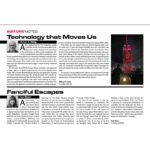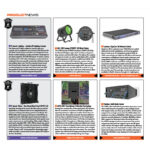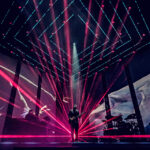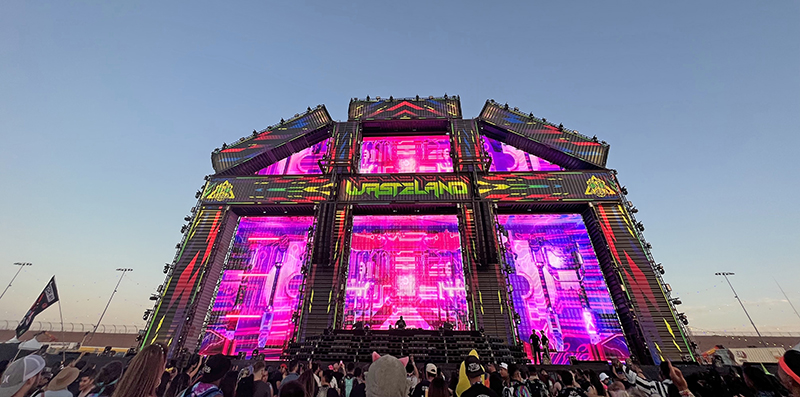
After a few years in Covid hibernation, fans are waking up ravenous for live music in a big way. Festivals are flourishing, filling calendars, with more major lineups announced every day. But this welcome boom in business comes with challenges. In the first part of this article, The Festival Landscape: Setting the Stage, PLSN asked Lighting and Production Designers Chris Lisle of CLLD LLC in Nashville and Patrick Dierson of Th3Activity in Las Vegas for their take on the trends in the current festival landscape. Following that interview is The Festival Landscape: Supplying the Stage, in which companies share how they’re fulfilling those equipment requests, highlighting inventories of proven products that are setting today’s stages.
The Festival Landscape: Setting the Stage
PLSN: How and when did you start designing festivals?
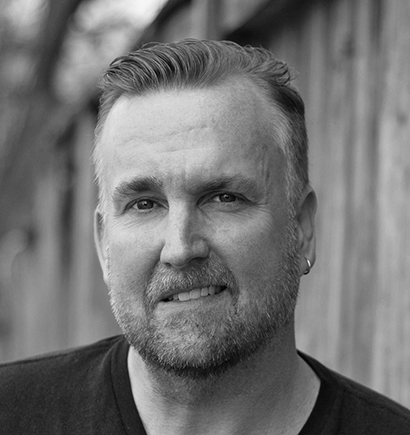
Chris Lisle: The first festival rig I designed was for KAABOO Del Mar in 2015. My good friend, Jim Dorroh, was the PM for the festival, and as we had worked on several other projects together, he brought me in to oversee lighting for all five stages along with site and architectural lighting. From that festival, it has snowballed into a good bit of our workload—especially with the festivals that C3 Events produces.
Patrick Dierson: I’ve been involved at various levels in festival designs going back to 2001. Many of those opportunities came about from concert touring, particularly overseas as festivals were more popular in areas such as Europe back then.
Name a few past and current festivals you’ve designed. How does your workload in 2022 compare with past years?
Lisle: We have been fortunate to do quite a few! KAABOO, Windy City Smokeout, Bonnaroo, Lollapalooza, Austin City Limits, Shaky Knees, Voodoo Fest, Sea.Hear.Now. New for us in 2022 are Innings Tampa, Lovers & Friends, When We Were Young, FORMAT, Smokin Grooves, High Water, and Oceans Calling. Our festival workload has almost tripled since pre-pandemic, and I am very grateful for the work.
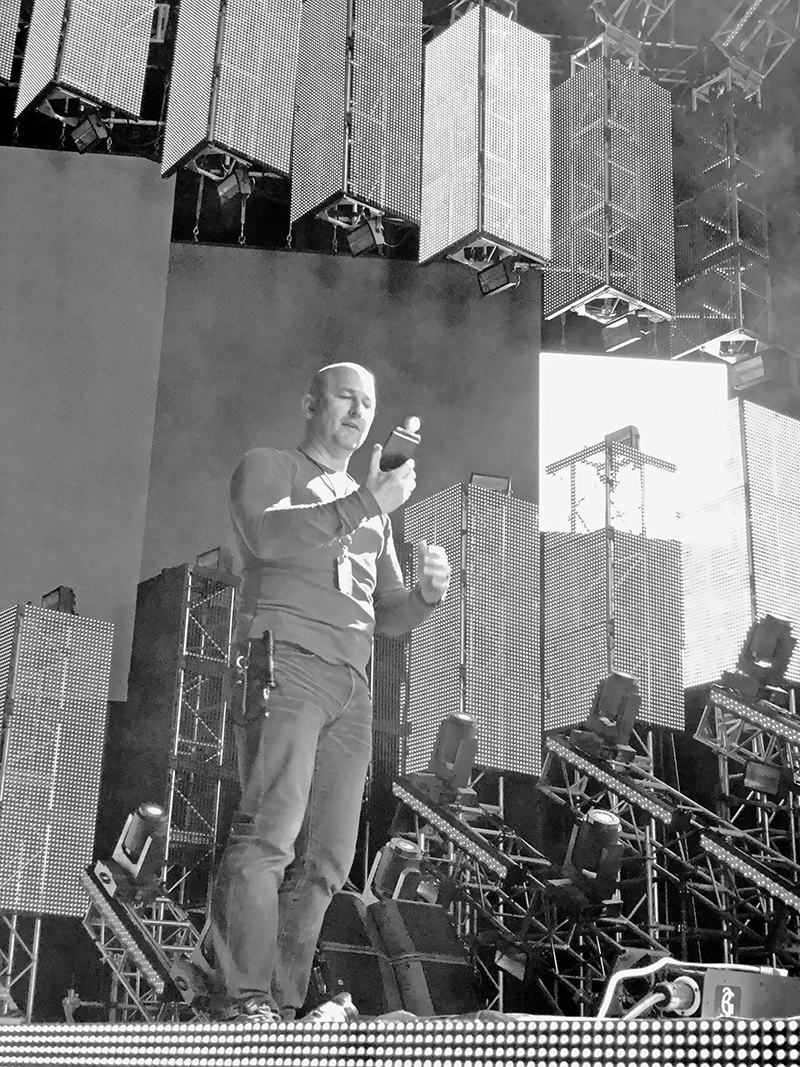
Dierson: I’ve designed various festivals for iHeart Radio, Ultra Music Festivals around the globe, Love Has No Limits, Made In America, and the list goes on. This year has definitely seen festivals making a comeback and the workload has stayed strong but is varied. Many festivals we’ve designed overseas have been slow to make a comeback and, in many cases, are doing so under extreme financial distress. Most of those entertainment properties blew through their financial reserves during the shutdowns and are desperately clawing their way back. This leaves many producers unwilling to afford the traditional expenses of traveling personnel long distances as they slowly recover financially. In some of those instances, we’re sending representatives from much closer regions to help execute the final products onsite.
By contrast, the U.S. is seeing some resurgence in newer festival properties popping up. We’re in talks with several new brands starting out in the second half of 2022 and into 2023. This is obviously an encouraging sign for the U.S. market, but time will tell just how well these new ones are received given their timing as we enter a difficult financial period for Americans who will not have the same disposable income to throw at tickets in the near future.
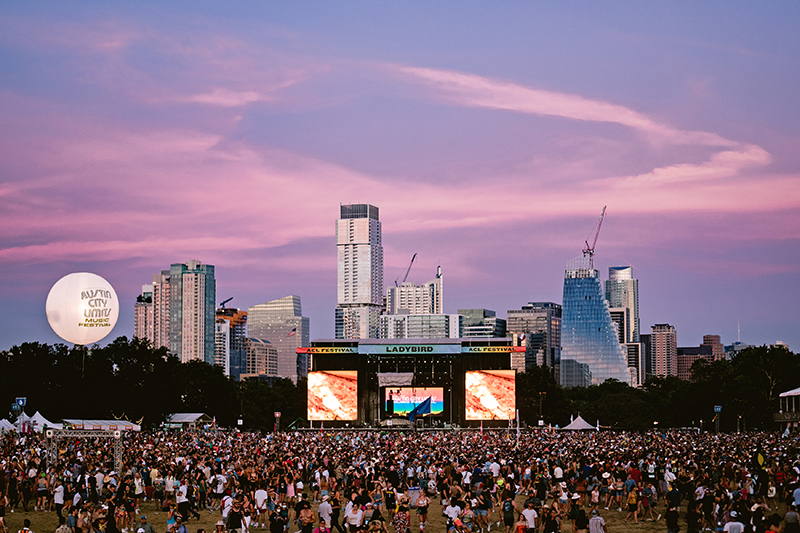
What has changed about festival design and production in recent years?
Lisle: Overall my design approach has remained consistent. The “boutique” festivals get a custom design with unique truss, fixture layout, and so on, whereas on the “big” festival mainstages I take the approach of making it simple with the ability to be cloned. We typically do three to four straight sticks loaded with a spot, wash, beam, LED strobe, and blinder. From there most LDs can do a straightforward, easy clone. So many headliners on big festivals are bringing in their own flown trusses/video/scenic to supplement the house rig, so keeping the trusses straight allows room within the roof grid to slot their elements—most of the time. I have noticed post-pandemic that many headliners are bringing in less flown supplemental production than pre-pandemic. I am not sure if this is a cost saving measure, supply/inventory limitations, or what.
Dierson: Money is the big change this year, and not in a good way since there’s never an appropriate way to dodge the cost of labor and shipping. With inflation and gas prices soaring, trucking costs have skyrocketed, and, unlike gear, gas is not negotiable and thus that hard cost gets passed on to the producers. We’re ultimately seeing a repeating theme here in that even if you can afford a lot of gear, you ultimately can’t afford to get it to the site and back. Overall, we’re seeing some reduction in the size of stages and, in instances where we are not, we’re seeing ticket prices increase to offset those increased expenses. In turn, we’re already seeing some concert tours and one-off events get cancelled due to lack of ticket sales as the American public weigh the option of paying for an event or having enough money for gas so they can get to work that week.
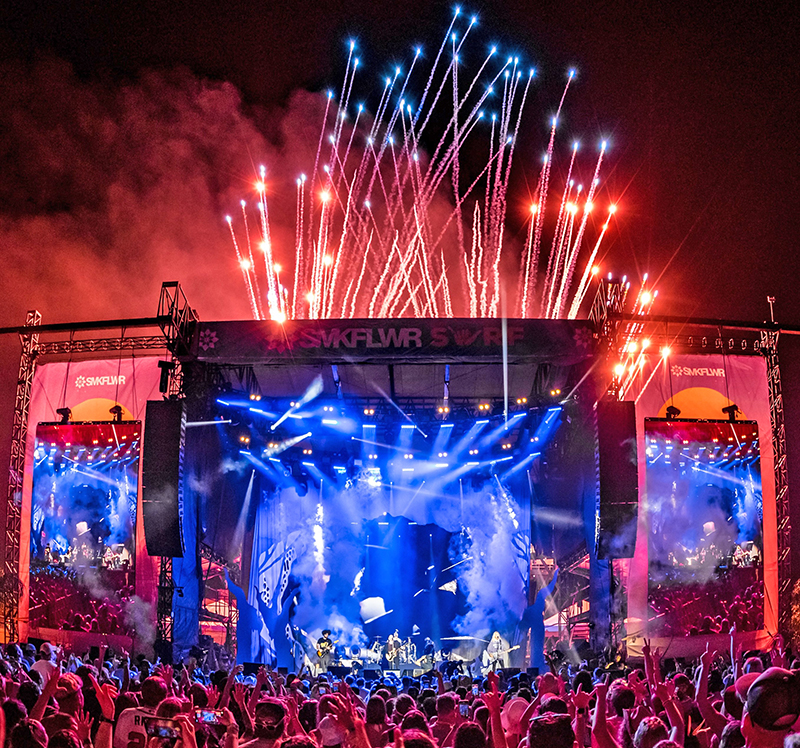
We’re hearing about equipment shortages. How are these, if any, affecting the design and specification of festival rigs you’re working on?
Lisle: We are not in an era of foot stomping “I want what I want.” You have to play in the vendor’s toy boxes these days. As long as a fixture is reliable, has the functions we need, and available, we will put it in a rig. Vendors are doing the best that they can to recover from the pandemic, and with supply chain issues, we need to be open minded to what they have in-house.
Dierson: Equipment shortages are most definitely an issue in the U.S., but we’ve been fortunate enough to get in front of that for most of the projects that we work on. It’s pretty simple: we put soft holds on the gear months ahead of time. Th3Activity is fortunate in having a significant amount of repeated yearly projects, so we start a rough design process well in advance of the project’s confirmation. It may not even be the design that we use but it gets gear held for our clients in advance, for fewer compromises rolling into the project. That ultimately skirts supply chain issues as much as is reasonably possible. We did this first with last year’s Made In America Festival. Tickets had not been released, nobody had confirmed that a show was happening or if we would be the ones coming back to design it, but we saw what was coming in May 2021 and jumped into action right then. Flash forward to the first day of load-in and the vendor representative exclaimed how it was the smartest move made that year given that they were officially out of gear for that time period a month earlier. We’ve kept that axiom moving forward and it has continued to pay dividends for our clients.
What, if any, go-to brands or fixtures do you rely on for your festival rigs?
Lisle: I have my favorite workhorses on a festival rig—and a lot of that has to do with what I think most LDs rolling in would be happy with. It’s not uncommon to see five to six different manufacturers represented in a festival rig. Each has done a good job of putting some great fixtures out. I also am conscious of specifying IP65 rated fixtures on the downstage truss and anything exposed to potential rain (stage wings). LED battens/tape are a great way to outline a rig/truss structure for sure and I love to do that when possible. Sometimes if you over-complicate these though, the guest LDs might have a funky clone—or ultimately just need to add them into their show programming.
Dierson: We have a saying: “We design for commerce.” It means we no longer gravitate toward having the newest toys on stage if we can get a much bigger show for the client by using what the vendor has in stock. We do everything in our power to avoid making our vendors sub rent specific equipment just because we want the hottest new thing. We’d rather put that portion of the budget into something that gets us more production and leave those hot new bells and whistles to the guest artists coming in with their floor packages. With that said, we’re seeing companies such as Elation and Chauvet become increasingly strong in the festival market due to their push toward manufacturing IP65 rated instruments. Let’s face it: outdoor festivals leave a lot of gear out in the elements, so IP65 rated kit wins the day, every day. I’ve had guest LDs complain that some units are much slower because of the nature of IP65 manufacturing but I counter that by asking, “Would you rather have a fast light with no light output because it’s been in torrential rain for a week, or would you prefer the slow guy with shiny bits coming out of it all the way to load out?”
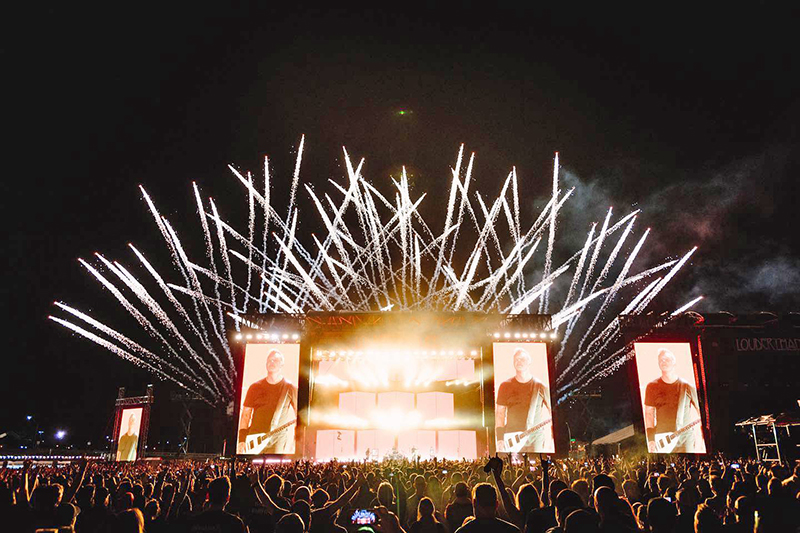
What role does new technology play in your rigs? Or do you have a basic festival formula that works for every event?)
Lisle: I stick to my spot, wash, beam, LED strobe, blinder formula as these are the most common elements most LDs will be cloning in.
Dierson: There are six basic properties of light that are required for festivals: spots, washes, strobes, strips, beams, and blinders. If you have those visual elements, then you are able to cater to all of your guest LDs coming in with their show files. Things become much faster for them to clone. After you have those, it’s all about where fixtures are living in space.
As for new technology, one of the main ones that we have embraced in recent years is remote followspots. Systems like Robe’s RoboSpot and PRG’s GroundControl Followspot System have changed the game for festivals in a way that not many people consider; you can still have followspots operating in highly inclement weather conditions. I can’t tell you how many times in the past two decades that I’ve seen headline acts have to perform without followspots because operators were called down from their positions due to storm cells moving into an area. It’s an unfortunate situation every time but crew safety always comes first. With remote spots, you can keep operators safely on the ground and still have the talent lit properly even if it’s raining sideways. That’s technology that becomes invaluable in those instances.
PLSN: How do you balance the needs of the headlining act LDs with your needs to cover a variety of bands in one rig?
Lisle: Occasionally we need to take into account a headliner’s need in the overall rig design, but with up to four headliners playing four different nights on the same stage, we keep the playing field even. Many times, if the acts have a specific fixture or look they want, they bring it themselves.
Dierson: Taking a guest artist’s supplemental equipment into account is always a challenging yet critical task. In many cases, we won’t even have an artist lineup to discuss at the time of design. One tactics we utilize the most is in trying to ensure that there are large openings within the rig through which other elements can be rigged. Rigging is usually the largest challenge and the rigging department’s primary limitations become airspace and weight load on the roof. For these purposes, we ensure that the design distributes weight as evenly as possible, and we will often discuss the potential for issues with the stage structure provider in advance so that extra reinforcement is a possibility earlier in the process rather than later.
As for the guest LDs coming in—success gets shared and we’re here to serve. We throw our egos straight out the window when it comes to festivals. Whereas we absolutely need to maintain control of our client’s brand-quality, a large part of that task is in keeping the quality of our support to guest artists as high as possible. We go out of our way to keep the technical information flow happening for guests, get a good bead on what they need, and keep a tight schedule in managing timing for guests in previz as well as on the stage with the actual rig. We make sure that all of the acts without LDs are taken care of but a large part of what we do onsite is FOH management to ensure that our guest artist technical teams have the smoothest experience possible. If we set them up for as much success as possible then we’ve not only made some friends, but we’ve ultimately kept the quality control high for our client’s brand. Everyone goes home happy.
Talk about the role of video compared to lighting, and any go-to brands in your toolbox.
Lisle: Video is definitely a major consideration in the overall festival production design. We always try to do side I-Mag screens, and in almost every case almost do an upstage video wall. Many acts roll in with custom content for a key part of their look, so we make sure we have them covered. Much like lighting, we are the mercy of what is available, but we are seeing a lot of the ROE [Visual] CB5 product out there.
Dierson: Massive amounts of video aren’t just for EDM clients anymore. Festivals rely heavily on video wall support, particularly for acts performing during the day where lighting elements are less impactful. That being said, it’s all about what our vendors have in stock and which of those products can be exposed to the elements.
One thing that we try to maintain is pixel pitch across the elements to keep visual continuity. Once we know what models of LED tile we have to work with, we pick the most appropriate pixel pitch to viewer distance and take it from there. In terms of brands, the ROE CB5 with its lightweight Air Frame technology and Absen’s IP65 rated VX5 products have served us very well the past few years.
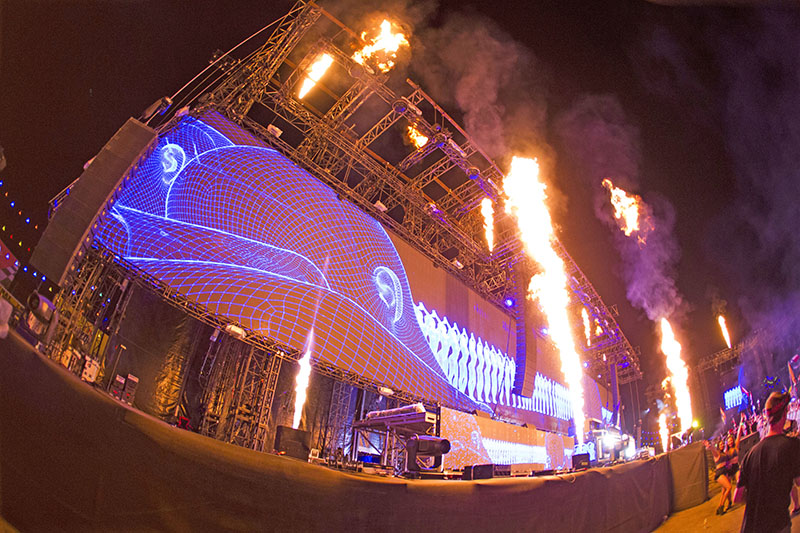
What is your advice to those wanting to get into the world of festival design?
Lisle: Ultimately, it’s not about what you—as the designer—want. You are going to have five to 35 different acts playing a stage on any given festival, pending how many days the festival is. Put yourself in the shoes of the LDs rolling in there and design a rig you would want to be on in that role—knowing you may not have much console time to do your clone and focus. Be organized, open-minded, and a good communicator. Make sure you do good paperwork.
Dierson: We live in a strange time for people entering the industry; there are a lot of people slapping the titles of “Production Designer” and “Creative Director” on their Instagram profiles and calling it a day. Many of the new guard think that it’s just about coming up with cool shapes and configurations while having little to no experience in doing the “production design” portion of the work. Every job has its crappy parts that go along with it. It’s really fun to design things with no basis in physics, availability, and budget but as an actual working Production Designer, you do not get to ignore any of those things. They’re inescapable. Another inescapable element is a savvy producer. That person doesn’t just want a pretty picture. They want—and need—an executable plan in how it all goes together, and that plan must fit their budget. They’re paying for an actual production design, not just your “bussin” idea that the computer program let you spit out. Everyone’s got cool ideas. Not everyone knows how to pull them off. What’s worse is that someone has to do that work no matter what and it’s usually the festival’s production manager who gets left holding that bag. So, to those wanting to get into this: get your hands dirty working on building these productions first instead of trying to flex for the Instagram. You may have luck selling yourself to an inexperienced producer, but you’ll ultimately be valued by how many of those producers hire you more than once, so learn the craft. Or don’t. Those folks just call us after those experiences and, for that, Th3Activity is extremely thankful.
What gives you the greatest satisfaction about designing festivals?
Lisle: The thing I love the most are the people who I get to meet and interact with. As we come out of this era of isolation with the pandemic, it’s just so good to see old friends and meet some new ones. That, and watching an LD rock a rig you designed is a lot of fun.
Dierson: The greatest part of festivals are those inexplicable “moments.” Whether you’re a part of the team directly creating them or you’re part of the team that created the overall playground in which they happen, the special moments that make tens of thousands of people scream, cheer, laugh, or cry, that’s the stuff that makes all the agonizingly difficult preproduction work worth it. Nobody’s 9-to-5 paycheck is giving anyone goosebumps.
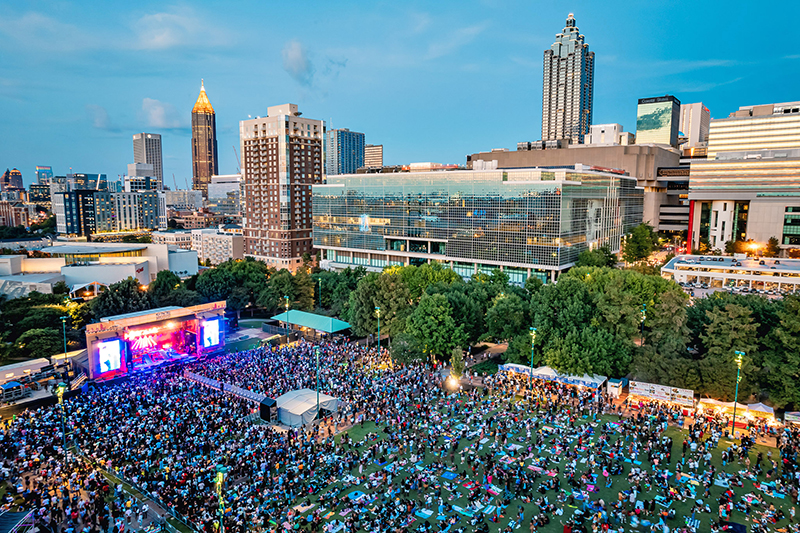
The Festival Landscape: Supplying the Stage
PLSN spoke with: Brown Note Productions’ President Ryan Knutson, 4Wall Entertainment’s Senior VP of Sales & Marketing Dan Abdalla, Bandit Lites’ Vice President of Production Dizzy Gosnell, Music Matters Productions’ Director of Marketing Lindsay Schwartz and Owner/Lead Production Designer Aaron Soriero, and 3G Productions’ CEO Keith Conrad.
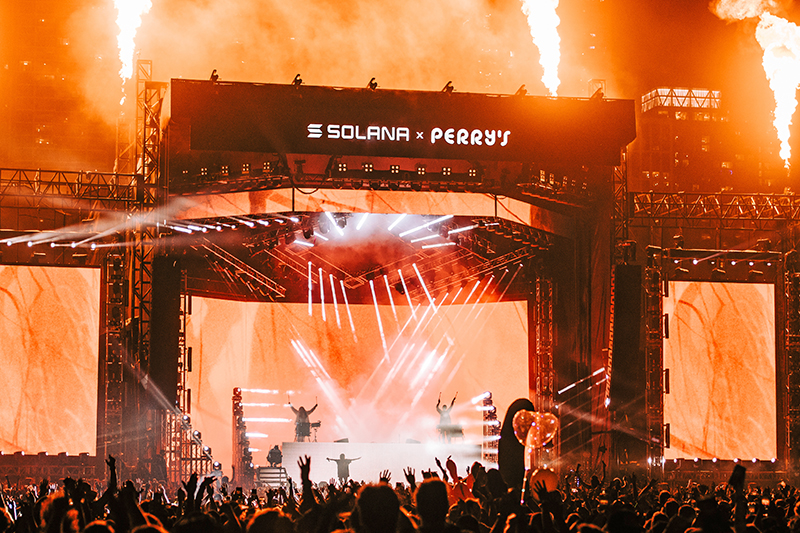
Name a few festivals you have worked on and tell us what’s coming up.
Ryan Knutson: So far this year, we have provided production for Okeechobee Music & Arts, Buku Music + Art Project, The Smokers Club, and Welcome to Rockville. We look forward to finishing out the year with upcoming festivals Inkcarceration, Global Dance Festival, Jazz Aspen Snowmass, Bourbon & Beyond, Aftershock, GoldenSky, and Decadence.
Dan Abdalla: Many of these festivals are returning for the first time since the pandemic and the overall reception and hype has been fantastic to witness. Already this year we were involved with EDC, Tortuga Music Festival, Bonnaroo Music & Arts Festival, and iHeart Radio Music Festivals. Upcoming: Excision Presents The Stadium, Project Z, Hard Summer (Stage 4), Made in America, Governors Ball, Faster Horses, and Lollapalooza.
Dizzy Gosnell: Bandit has through the years worked with multiple major festivals, including Bonnaroo, Forecastle, Firefly, Lollapalooza, Austin City Limits, Lost Lake, Hangout, Electric Forest, SXSW, Governors Ball, Big Ears, Blue Ridge Rock Festival, and several others.
Lindsay Schwartz: Year to date, we have provided production services for 16 festivals—such as Shaky Knees, High Water Festival, Atlanta Jazz Festival, Forecastle Festival, Electric Forest, and Something in the Water—and we have 10 already on the books for the fall including Afropunk Atlanta & Brooklyn, Moon River, Music Midtown, Sea.Hear.Now., Oceans Calling, ONE Musicfest, and more.
Keith Conrad: Since the live music industry restarted around the fall of last year, we have provided production support for numerous music festivals, including: EDC Las Vegas, Beyond Wonderland, Vibra Urbana Las Vegas, Wango Tango, Coachella (various artist support), Calibash, Super Bowl Music Fest, and LA Pride Festival. Most of these clients we have long standing relationships with and have worked with for years pre-pandemic.
What part of festivals do you typically provide?
Knutson: Audio, lighting, video, SFX, backline.
Abdalla: Lighting, video, staging, rigging, and a wide range of services required for the shows.
Gosnell: Just lighting.
Schwartz: Our team provides anything on the production side of a festival: lighting, audio, video, staging (we’ve got a fleet of mobile stages), creative design, project and production management. We also have a partnership with SES called 360Festivals, which allows us to combine our collective resources. We’ve both been able to expand our festival service offerings to include field protection, crowd control barricades, trucking and transportation, steel structure large format stages, and more.
Conrad: We have historically been more of an audio provider but since the pandemic, we have recapitalized the company and invested heavily in lighting, video, and rigging, so we are now providing more full-service production for festivals.
How does your 2022 festival workload compare prior to the pandemic?
Knutson: Since our return in April of 2021 to large scale concerts and festivals we have seen a steady increase in festival opportunities. As a company we are currently booked for more festivals in 2022 than we were in 2019 pre-pandemic. It’s great to see all of the bands and crews again out there at these events!
Abdalla: For the most part, the amount of festival work is back to what it was pre-pandemic.
Gosnell: Bandit has had a very reduced festival offering this year caused by high touring demand and shortages of qualified people.
Schwartz: Our festival production has more than doubled. We probably used to do around 12 per year, and we’re already at 26 booked for 2022. It seems like we’re adding a new festival every week.
Conrad: Festival work has come back strong. I would venture to say festivals are up from a volume perspective compared to pre-pandemic. We own more equipment now across all disciplines—audio, lighting, video, rigging—so we are able to provide more one-stop shopping to festival producers, which makes our company attractive for these events.
What has changed about festival production since the pandemic?
Knutson: Production is getting bigger and starting to grow again. We are seeing a resurgence in creativity from the festival designers and production teams. It’s exciting!
Abdalla: The enthusiasm and passion from the folks who build these stages to the vendors providing gear, food, and memorabilia is at a level I’ve never seen before. Before the pandemic, when festival season would roll around, yes, everyone was excited, but nobody anticipated what the pandemic would do to the industry for two years. Now that festival season is returning to normal, nobody takes these incredibly difficult, time consuming, and satisfying weekends for granted. We cherish every second of it and when the doors open, the festival goers feel that energy.
Gosnell: The main changes have been more detail on pre- and post-festival logistics with rigging, trucks, local hands/riggers, and so on.
Conrad: Designers are more open to substitute products, particularly on the lighting side. With the shortage of equipment and festivals coming back strong, producers and designers are satisfied when we have the equipment to fulfill the majority of the rider and can find substitutes for others. Talented technicians, engineers, and workers are overall very challenging to find. Many people have left the industry and haven’t come back post-pandemic. This is impactful on the client side from planning and execution as well as for us with technicians.
What trends are you seeing and what go-to fixtures are being requested?
Knutson: We are seeing more scenic elements as well as more IP65 rated fixture requests [for outdoors], which are critical for these systems. Luckily, we have invested heavily in these technologies.
Abdalla: IP65 rated fixtures are becoming requested more regularly and are huge for the festival market. Over the last year we’ve added hundreds of IP65 rated light fixtures from Chauvet Professional, Elation Professional, and Ayrton. We also have IP65 rated LED video panels as that are a huge page of a music festival’s stage design.
Gosnell: This year we’ve seen more requests for remote followspot systems of all types, and higher output haze to name two, but generally acts have been fine with an across-the-board range of lamp styles (wash, spot, beam, strobe/blinder/wash) in the systems and have been more accepting of alternatives of different fixtures in the same style. For example, [Ayrton] Khamsin or Ghibli or [Robe] BMFL or [Martin] Viper FX, which this year have been beneficial with the high project load.
Soriero: Video content is king: I-Mag is bigger, there are more cameras, and there’s definitely a broadcast feel. And there is still a big livestream component to most. There is also a lot of extra attention being paid to lighting and special effects in the production. Moving head LED strobe fixtures opened up a “new normal” as have a lot of [GLP] JDC1s as well. There is also an increased need for IP-rated fixtures on the downstage trusses and exposed areas of the stage.
Conrad: The visuals are the most important aspect, so you are seeing huge lighting rigs and significant video deployed on shows. From a layout perspective you are seeing some changes too that are more beneficial to the fan experience, such as a lack of fencing to allow for snakes to go from FOH to stage. This makes it harder for technicians/engineers to get back and forth. However, it opens up the area for fans in front of the stage and allows for more free movement. This could be in response to some [crowd] issues that have happened at shows such as Astroworld.
On the lighting side, it is Robe, Elation, Chauvet, and GLP, mostly with [MA Lighting] grandMA consoles. On the video side, it is mostly pixel pitch driven but higher end, bigger festivals like to see the ROE Visual product as it is more efficient to put up and down, which saves money. Additionally, we’re seeing the ability to do blow-through video walls, especially in windy environments like Las Vegas.
Some production companies do the festival design themselves rather than bring in outside lighting designers. What does your company do?
Knutson: We do a combination of this. We have our in-house design team as an option for our clients and also support a variety of designers who work with our clients.
Abdalla: We are generally the gear vendor and work with production companies who hire the LDs.
Gosnell: Bandit has worked in both environments.
Soriero: Some promoters hire a designer to provide the general idea of the festival rigs and then we construct everything from their designs. Some promoters look to us for complete design and we can do that in-house. We’re usually thinking about a rig that can give solid looks for everybody but can be flexible enough to fit in headliner needs. I do a lot of the lighting design for festival rigs, but we’ve also worked with Chris Lisle a great deal, as well as PHNTM Labs.
Conrad: We mostly design our own as we have in-house designers. However, we are happy to work with designers as well and oftentimes take a collaborative approach with them.
We’re hearing of equipment shortages. How are you meeting product demand?
Knutson: There is a high demand for inventory and the supply is running short. We kept our steady purchasing up through 2021 to get ahead of the shortages and our growth in 2022. We are focusing on making sure our existing and long-term clients get what they need first as they are the customers who have kept us in business and helped us grow over the years. We are being responsible with adding new clients and only taking on what is manageable with our current inventory and crew. We continue to invest in the new technologies and, more importantly, new technicians and management.
Abdalla: Like many in the industry, receiving new gear has had some delays, but for the most part our new Absen, Ayrton, Chauvet, disguise, Elation, ETC, Tomcat Truss, Tyler Truss, and other gear has been coming in on schedule. We have been—and continue to be—aggressive in purchasing gear for our clients across all our locations. Our rental agents and asset management team meet regularly and often to ensure our gear is where it needs to be for our clients. They do a fantastic job.
Gosnell: Bandit has—and is—purchasing equipment when and where we can. The supply is simply not meeting the demand across all genres. The available list of equipment and great people serve to limit what any firm can deliver, and Bandit will not deliver inferior people or illumination. This drives us to sometimes not being able to service events we would love to service.
Soriero: There is definitely a shortage of equipment and lead times have been insane. We have a lot of fixtures ordered: some can ship now; some are months away and into next year. We are having to cross rent until that inventory has arrived. It helps to have friendly relationships with others in the industry so we can all lean on each other during these weird/tricky times.
Conrad: Equipment shortages are real due to supply chain issues. Further with demand exceeding supply, we are seeing pricing increase from the manufacturers. We had some foresight and put orders in during Q4 2021, which allowed us to receive most of our equipment in time for touring and festival season starting in May. Further, the price of used equipment has increased significantly. Some of our decisions in purchasing were based on availability from manufacturers. Lastly, aiding in the supply/demand imbalance is the fact that companies that went out of business coupled with the majority of bands touring and all festivals wanting to turn the lights back on after two to three-years off. As a result, we have seen the ability to alter designs if we don’t have the specified equipment for a designer.
How are labor shortages affecting your festival work?
Knutson: There are labor shortages all around us. We are doing our best and our headcount is up by 25% from 2019 to 2021. We are continuing to hire all positions. We are seeing more issues in the local labor shortages with stagehands. This seems to be the largest issue in the industry as there have been countless shows with stagehand calls that were well below what was ordered and needed.
Abdalla: It’s no secret a lot of freelancers left the business during the shutdown. Our labor coordinators have had their hands full finding labor for some jobs, but overall, as things start returning to normal, we are seeing an uptick in freelancers responding to jobs. We have worked diligently with IATSE, USITT, ROCU, and more to find talent around the country.
Gosnell: The severe lack of good, qualified people is impacting the entire industry. Bandit has made the conscious decision to accept less work rather than offer unqualified people and less than desirable equipment. This is not a hard decision at all and is in the best interest of our valued clients.
Soriero: The demand for our services is far exceeding our supply of labor. We’re being forced to choose between gigs and turn some down, which is a really interesting feeling considering what we went through with Covid. We’ve accepted that we probably can’t totally solve the problem for this season/this year, but we’re working on solving it long-term and into next year with training programs, internships, and working with the staff we have to expand their skillsets.
Conrad: This is real. Many quality technicians have left the business during the pandemic and still haven’t returned, and probably never will. We have addressed this by finding young talented people that are looking for a career path. If you have a good work ethic and an eagerness to learn, you can be successful in this business. The barrier to entry for someone new is low as there aren’t education prerequisites or prior job training. It is mostly on the job training, so we pair these new candidates with veterans on our team and show them the 3G way to do things. So far it has been refreshing to bring young quality workers in and watch them grow.
